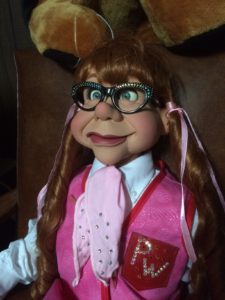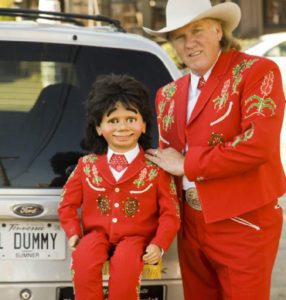The Story About The Ventriloquist
The Story
About
The Ventriloquist
When I was young, there were some television programs that would feature ventriloquists. Seeing a guy with a dummy, or a puppet, and make it appear to talk was very interesting to me and fascinated me. I guess I instinctively sensed a desire to duplicate that action. I thought it would be wonderful to be able to perform with a “dummy” or a ventriloquist partner and amaze all onlookers and people who could see me do this.
I will first of all, offer some insight into the art of ventriloquism, and about ventriloquists and their ventriloquist figures (or “dummies”).
Ventriloquism is an illusion. You don’t actually “throw’ your voice, and your voice doesn’t actually project from an object or character that is some distance from your own body. Your voice will always come from the same source it always has come from, your own body and your own vocal chords.
Here’s where the “illusion” comes in.
Your hearing, is one of the least accurate of most of your body’s senses. (Sight, Smell, Touch, Taste, and Hearing)
Sound travels in all directions at once. If you hear a police siren outside your home, you may look outside your door, and then use your sense of sight with your eyes, to look each way, left and also right, to verify and reinforce which direction the siren sound is coming from. So, you used your eyes to confirm the source and location of the siren sound.
If you are watching a motion picture movie in a movie theater, the person who is the image on the screen in the front of the theater is shown talking. Well, on the side walls of the theater, are normally speakers pointed towards the audience members in the theater (you!). As the character in this movie talks, you see the image speaking, but there are not any speakers on the surface of the movie screen. The speakers are on your left, and on your right, and perhaps behind you, and overhead. But, the image of the person you see talking is talking at the same rate, and is synchronized at the same precise moment that you hear the sound of his voice, and see his lips moving to match what you’re hearing at that moment.

So, the sound you hear is NOT coming from the character on that flat screen in front of the theater. It’s coming from the side wall speakers! But, seeing this character being animated and moving his lips at the same rate as the sound you’re hearing, it becomes a believable “illusion” that the person on that flat screen is actually “talking”.
The same thing applies to ventriloquism.
If you see a ventriloquist with his “dummy” say something, here’s what happens.
The ventriloquist says something, just as you would speak to say something. Then, the “dummy” says something. To accomplish this, the ventriloquist speaks for the “dummy”, while using a different range of voice than his own normal speaking voice. So, most ventriloquists use a higher range of tone voice for their dummy, or sometimes a much lower tone of voice for their character. This gives “contrast” between his own normal speaking voice, and gives a different, separate identity to his character’s voice. Well, the ventriloquist tries to not visibly move his lips, while at the same time, looking directly at his character (the dummy) while the dummy is talking and being animated by moving his mouth, and sometimes some eye movement. By looking toward his dummy, while the dummy is speaking, it allows spectators to believe that the dummy is speaking, and the ventriloquist is simply looking at his partner speak (just as you would politely looks directly at the person that’s speaking to you).
When an audience member is a distance away from the ventriloquist and his dummy, it’s very easy to visualize that the dummy is actually “talking” and the ventriloquist is “throwing his voice into this character dummy”.
If the ventriloquist were to place his dummy at the back of the room, with the audience in between himself and his dummy, then it would no longer have the same effect. The ventriloquist’s voice would of course still come from his own body, and would be unable to have sound project from the dummy at the back of the room.
I know,……….that’s a whole lot more information than you really wanted to hear, isn’t it?
Well, I was spellbound, and fascinated, and I wanted to be able to be a ventriloquist.
The following people were an influence on me becoming interested in this ancient art.
These people were pioneers and world famous icons that established the art of ventriloquism for millions of people who enjoyed their style of entertainment. These folks made this wonderful type of showmanship available for lots of others.
Paul Winchell had a television show, that featured his characters, and was popular for many years. Winchell's best-known ventriloquist dummies were Jerry Mahoney and Knucklehead Smiff.
I remember seeing Edgar Bergen, (Candice Bergen’s father) who was popular since the Vaudeville days, which were live stage shows held throughout the country, prior to television and radio. Edgar Bergen was a very well known ventriloquist, and was featured on radio programs with major celebrities such as Mae West, prior to television becoming available. His characters were Charlie McCarthy, and Mortimer Snerd, with Effie Klinker. Edgar Bergen was not known to be a great ventriloquist as far as hiding his lip movement. He would normally visibly display his lips pursing and being shown to move, while “throwing” his voice into one of his characters.
Senor Wences also was a popular guest on The Ed Sullivan Show, and was a Spanish ventriloquist.
Jimmy Nelson had a television show that ran throughout the 1950’s and ’60’s. His major sponsor became Nestle’s corporation, with Nestle’s Quik being a favorite children’s instant mix chocolate drink. His characters were Danny O’Day and Farfel the Dog.
Shari Lewis was extremely popular with a little sock puppet named, “Lambchop” and a horse puppet named, “Charlie Horse”.
The late 1970’s brought a television show called, “Soap”, a soap opera satire, and featured a young Jay Johnson with his dummy, “Bob”.
At the same time, a black ventriloquist named Willie Tyler, and his dummy, “Lester” became popular as a guest on numerous television shows and variety programs.


In 1981, I was working for Saudi Arabian Airlines in Jeddah, Saudi Arabia, as an aircraft radio/radar technician. I decided that the next trip home to the United States, that I would go into a large bookstore and try to find some books that would help me to become a ventriloquist. Well, the books that I did find at that time, were not entirely sufficient to help me accomplish this. However, in the back of one the books, I saw some suppliers of “dummies” or ventriloquist figures listed. One of these, was Maher Studios, in Littleton, Colorado. I sent for some information by mail, and received their catalog. The catalog had various cloth puppets, furry animal characters, and also professional ventriloquist figures carved from wood, with mechanical features such as raising eyebrows, eyelids that would wink, etc. The catalog also showed a home study course that included cassette tapes for instruction, and small multiple booklets that followed the sequence of the cassette tapes. Keep in mind, that this was prior to video tapes becoming widely available. Also, of course, this was many years before the internet and YouTube and other online instruction and information.
The real clincher for me, was when I saw that one of my heroes, Willie Tyler and his pal “Lester” was a former student of this home study course. I thought, if this course is how Willie Tyler started, and became successful, then I was very excited to follow in Willie’s footsteps. Well, I ordered the instruction course, that included the booklets, and cassette tapes. I didn’t immediately order a “dummy” or puppet character. I thought I would first try to see if I could actually become proficient at this new skill or talent. I initially used a “sock puppet” by simply taking a white gym sock, and putting my hand and forearm into the sock, and using a black magic marker, marking “eyes” onto this sock. I would then position my hand, and separate the sock to allow it to look as though it had a moving mouth. When I arrived at the point that I could envision myself actually “throwing my voice”, I went ahead and ordered a professional ventriloquist figure from Maher Studios. In 1983, I ordered the “Jingo” character that they offered, and he was quite large (size 8 boys clothes). His head was carved from a lightweight wood called “basswood” and I was very excited to meet my new friend and partner.
I sing and play country music, so I thought I would like my character to have a “country boy” image. I needed a name for him. Well, I looked into the Rand McNally Road Atlas. In this Atlas, it normally list the individual towns and cities of each state in alphabetical order. I’m from Hazard, Kentucky originally, so I thought that perhaps the great state of Kentucky could provide me with a name for my new partner. I started in the “A’s” and found a town in Kentucky named, “Arjay”. I went on to find in the “B’s” another town called, “Buechel”. As I scanned even further, I saw a town named, “Turkey Creek”. Well, it just seemed to flow. Suddenly my new partner, became “Arjay Buechel, from Turkey Creek, Kentucky”.
After receiving my new buddy from Maher Studios, I was eager to learn more about ventriloquism, and how to put this all together into some sort of order that would cause people to be amused, entertained and to laugh, of course.
This would prove to be more difficult than I imagined it to be. It didn’t really seem that I was throwing my voice, because your voice is never actually “thrown”. The sound of your voice, as you are trying to project a voice for your “dummy”, always originates in your own throat and vocal chords.
In more recent years, David Strassman, Taylor Mason, Ronn Lucas, and others became well known.
Jeff Dunham set a new world standard of popularity for ventriloquists EVERYWHERE. His characters became household words.
Terry Fator, and Darci Lynne Farmer were both winners on “America’s Got Talent”, and have become well known.
And then there’s me: Here I am, a senior citizen now, writing and singing traditional country music, and living in Nashville, Tennessee. I use my ventriloquist dummies in my entertainment shows. “Arjay Buechel” has become my main character, and I have added “Polly Wynotte” to the act. (I always liked Dolly Parton, and Tammy Wynette, so I named her “Polly Wynotte”)
Keep following me to see what happens in my career next!!!!!!
Thanks so much for your interest in ventriloquism, and if you’re interested in pursuing it, there are many ways to find out about it and learn how to perform it. There are many YouTube videos that are helpful, and many websites that offer puppets, dummies, and learning materials.
Good Luck!!!
Your pal,
Merlin Gene
The Merlin Gene Show
